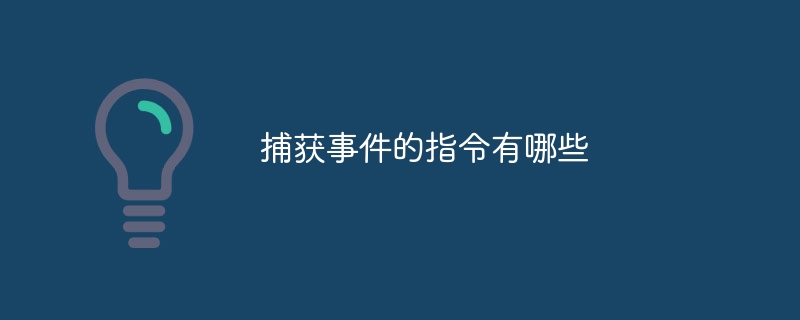
The instructions for capturing events are: 1. addEventListener; 2. attachEvent; 3. on; 4. bind; 5. unbind; 6. trigger; 7. hover, etc. Detailed introduction: 1. addEventListener, which is the most commonly used capture event command, which allows adding event listeners to elements; 2. attachEvent, which is the event binding method of the old version of IE browser. Events bound using this method can only Works in IE browser and more.

The operating system for this tutorial: Windows 10 system, DELL G3 computer.
The instructions for capturing events mainly include the following:
1. addEventListener: This is the most commonly used capture event instruction, which allows you to add event listeners to elements. . You can specify the type of event to capture, the event handler, and whether the event is triggered during the capture phase or the bubbling phase.
Example:
element.addEventListener('click', function() {
console.log('点击事件被捕获');
}, false); // 第三个参数为false表示在冒泡阶段触发事件2. attachEvent: This is the event binding method of the old version of IE browser. Events bound using this method can only be used in IE browser. work. It is similar to addEventListener, but the syntax is slightly different.
Example:
element.attachEvent('onclick', function() {
console.log('点击事件被捕获');
});3, on:This is a simplified method for directly binding event handlers. It accepts two parameters: event type and event handler.
Example:
element.on('click', function() {
console.log('点击事件被捕获');
});4. bind: This is jQuery’s event binding method. Events bound using the bind method are triggered in the bubbling phase by default.
Example:
$(element).bind('click', function() {
console.log('点击事件被捕获');
});5. unbind: This is jQuery's event unbinding method, used to remove bound event handlers.
Example:
$(element).unbind('click'); // 移除所有点击事件处理程序
6. Trigger: This is jQuery's event triggering method, used to manually trigger the specified event. You can pass an object containing event data as a parameter.
Example:
$(element).trigger({ type: 'click' }); // 手动触发点击事件7, hover: This is jQuery’s shortcut method for binding mouseenter and mouseleave events at the same time.
Example:
$(element).hover(function() {
console.log('鼠标进入元素');
}, function() {
console.log('鼠标离开元素');
});These are common event capture instructions used to handle various events in the DOM. Which directive to choose depends on your specific needs and use case.
The above is the detailed content of What are the instructions for capturing events?. For more information, please follow other related articles on the PHP Chinese website!




